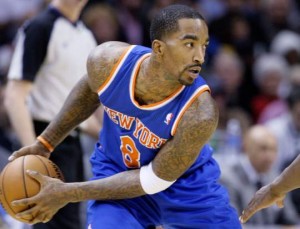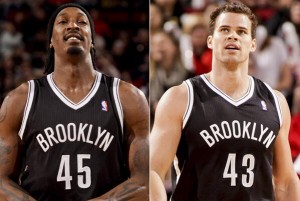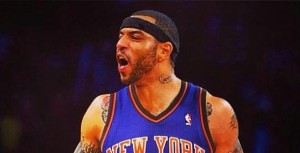 Coming into this season, I had the New York Knicks taking a step backward in my Sheridan Hoops preview column. But not this far back.
Coming into this season, I had the New York Knicks taking a step backward in my Sheridan Hoops preview column. But not this far back.
New York is tied for the second-worst record in the Eastern Conference with a 3-8 mark and J.R. Smith, arguably the team’s second best player, is in crisis mode.
“They say it’s too early to panic,” Smith said after Wednesday’s hard-fought overtime loss to Indiana, the team’s sixth straight home setback. “Me personally, I panic. I don’t like this. I don’t want to play 3-8 basketball. I don’t want to play 50-50 basketball. If we’re going to be a championship caliber team and call ourselves that, we’ve got to play like that. We can’t be any other way.”
Despite the underwhelming start, all is not lost for the Knicks. And now is not the time to panic.
After all, early starts don’t always dictate the outcome of an entire 82-game season.
Last season, the Charlotte Bobcats started 7-5, and the franchise looked like it had turned a corner – right into a dark alley. The Bobcats lost their next 18 games and finished 21-61.
Conversely, the Miami Heat started 9-8 in the 2010-11 season, the first with the “Big Three.” The Heat snapped out of it with winning streaks of 12, nine and eight games, finishing 58-24 and reaching the NBA Finals.
With that in mind, here are my three assessments of the current state of the Knicks:
1. Do not panic and make a trade. Unless, of course, you’re Smith. Then you “panic” after 11 games, less than a seventh of the season.
Knicks fans must hope the front office – no longer run by Glen Grunwald, now run by Steve Mills – has more patience than Smith. Recently, trade rumors of Iman Shumpert to Denver for Kenneth Faried and Amar’e Stoudemire to Boston for Kris Humphries and Gerald Wallace have surfaced.
Both would be bad moves in the short and long term while showing signs of panic from management.
Carmelo Anthony is the face of the franchise and has played the best basketball of his career at power forward. Why trade for Faried, who plays the same position?
The thinking behind the rumor is that Faried would help on the glass, but with Anthony averaging a career-high 9.5 boards, more rebounding isn’t needed.
The eventual return of Tyson Chandler will compensate for the lack of rebounding where it is currently lacking, at center.
While Stoudemire has been a shell of his former All-Star self, adding Humphries and Wallace would be a huge mistake.
Humphries would be more durable and a rebounding rental upgrade over Stoudemire but lacks his offensive prowess and would be a lightning rod for the New York media and fans. By the way, he also plays power forward.
Wallace is in the twilight of his career due to reduced athleticism but still has another two seasons and $20 million on his deal. If you thought Stoudemire’s deal was bad, Wallace’s deal is even longer and would eat up valuable 2015 cap space, when the Knicks could make a run at unrestricted free agents such as Kevin Love.
The front office – and Smith – should be comforted by the impending return of point guard Raymond Felton to the lineup, with Chandler possibly a few weeks away. Once both return, expect more pick-and-roll plays on offense.
On defense, expect New York to improve mightily with Chandler – the defensive anchor – back in the middle to patrol the paint. Without Chandler, the Knicks are 0-6 when allowing over 100 points.
Smith has also slowly begun to round into form after shaking off the rust from his five-game suspension.
Most importantly, the Atlantic Division is woefully weak. Despite all the turmoil, the Knicks are only 1 1/2 games out of first place.
It’s an 82-game season, not an 11-game season.
If the Knicks don’t “figure it out” as Anthony has repeatedly stated by the 30-game mark, then hit the “panic” button.
2. Find an identity. The Knicks have shuffled through five different starting lineups through the first 11 games. This is partly due to Smith’s five-game suspension and Chandler’s injury.
However, it doesn’t change the fact that it’s hard to build chemistry and win without consistent lineups and defined roles.
With Chandler and Felton out, the Knicks must compensate for the lack of talent in the starting lineup with players who will bring sustained effort throughout the game.
In the loss to Indiana, the Knicks showed consistent effort throughout an entire game. They played extremely hard and put themselves in position to win against the league’s top team.
That was not the case during a 40-point first quarter against the Minnesota Timberwolves, a 31-point shellacking by the San Antonio Spurs and a 20-point dud against the Atlanta Hawks.
“We can’t be sitting in a locker room talking about effort,” said Smith. “That’s one thing you can’t teach – effort. You have to play through it, no matter who’s calling the plays, whoever is calling the shots from above. Effort shouldn’t be our problem and that’s what it is on defense. Defense is full of effort and we’re not playing it.”
Martin must withstand playing 30 minutes on a consistent basis – especially on back-to-back nights – to give the Knicks a fighting chance to control the glass. His toughness is needed and could be infectious.
Stoudemire has also seen increased minutes, but rebounding – and defense in general – has never been his strong suit.
Anthony has rebounded at the highest rate of his career. But the Knicks still rank 29th in defensive rebounds (28.0) and total rebounds (39.64).
When Felton returns, coach Woodson must decide if he is better suited with Pablo Prigioni or Beno Udrih as his primary backup point guard.
Prigioni is a hard-nosed defender with quick hands who never takes plays off and is an above-average 3-point shooter nicknamed “The Maestro” for his ability to orchestrate the offense. Udrih provides more natural scoring ability off the dribble, evidenced by his 19 points vs. Indiana.
Lastly, Anthony must remain at power forward when Chandler returns and Andrea Bargnani must come off the bench.
This is not a knock on Bargnani’s play at all, but rather a product of poor floor spacing and chemistry when all three play together on the same unit.
Anthony excels at beating slower power forwards off the dribble and creating space with his step-back dribble. Bargnani has thrived similarly by forcing opposing centers to guard him along the arc.
Most opposing centers don’t roam beyond the foul line, which allows Bargnani better looks at the basket. When slower defenders rush out, Bargnani has utilized an effective pump fake and stepped up for open looks to start the season.

